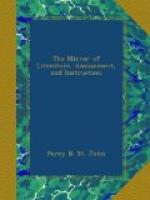In the year 1812, Mr. Davy married his amiable lady, then Mrs. Apreece, widow of Shuckburgh Ashby Apreece, Esq. and daughter and heiress of the late Charles Kerr, of Kelso, Esq. By his union with this lady, Mr. Davy acquired not only a considerable fortune, but the inestimable treasure of an affectionate and exemplary wife, and a congenial friend and companion, capable of appreciating his character and attainments. A few days previously to his marriage, he received the honour of knighthood from his Majesty, then Prince Regent, being the first person on whom he conferred that dignity.
We now arrive at the most important result of Sir Humphry Davy’s labours, viz. the invention of the SAFETY-LAMP for coal mines, which has been generally and successfully adopted throughout Europe. This invention has been the means of preserving many valuable lives, and preventing horrible mutilations, more terrible even than death; and were this Sir Humphry Davy’s only invention, it would secure him an immortality in the annals of civilization and science. The general principle of this discovery may be described as follows:
“The frequency of accidents, arising from the explosion of the fire-damp, or inflammable gas of the coal mines, mixed with atmospherical air, occasioned the formation of a committee at Sunderland, for the purpose of investigating the causes of these calamities, and of endeavouring to discover and apply a preventive. Sir Humphry received an invitation, in 1815, from Dr. Gray, one of the members of the committee; in consequence of which he went to the North of England, and visiting some of the principal collieries in the neighbourhood of Newcastle, soon convinced himself that no improvement could be made in the mode of ventilation, but that the desired preventive must be sought in a new method of lighting the mines, free from danger, and which, by indicating the state of the air in the part of the mine where inflammable air was disengaged, so as to render the atmosphere explosive, should oblige the miners to retire till the workings were properly cleared. The common means then employed for lighting the dangerous part of the mines consisted of a steel wheel revolving in contact with flint, and affording a succession of sparks: but this apparatus always required a person to work it, and was not entirely free from danger. The fire-damp was known to be light carburetted hydrogen gas; but its relations to combustion had not been examined. It is chiefly produced from what are called blowers or fissures in the broken strata, near dykes. Sir Humphry made various experiments on its combustibility and explosive nature; and discovered, that the fire-damp requires a very strong heat for its inflammation; that azote and carbonic acid, even in very small proportions, diminished the velocity of the inflammation; that mixtures of the gas would not explode in metallic canals or troughs, where their diameter was less than one-seventh of an inch, and




